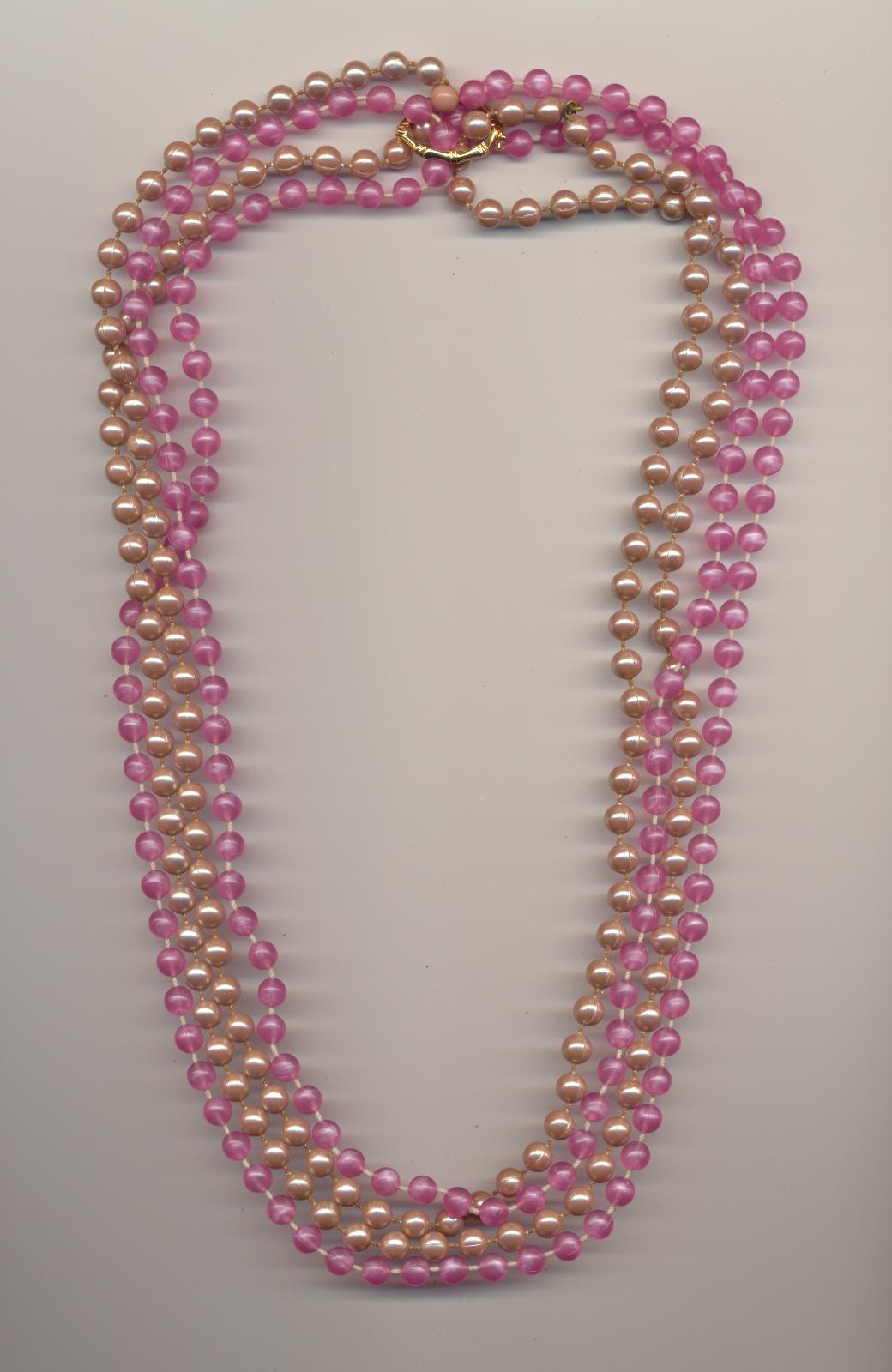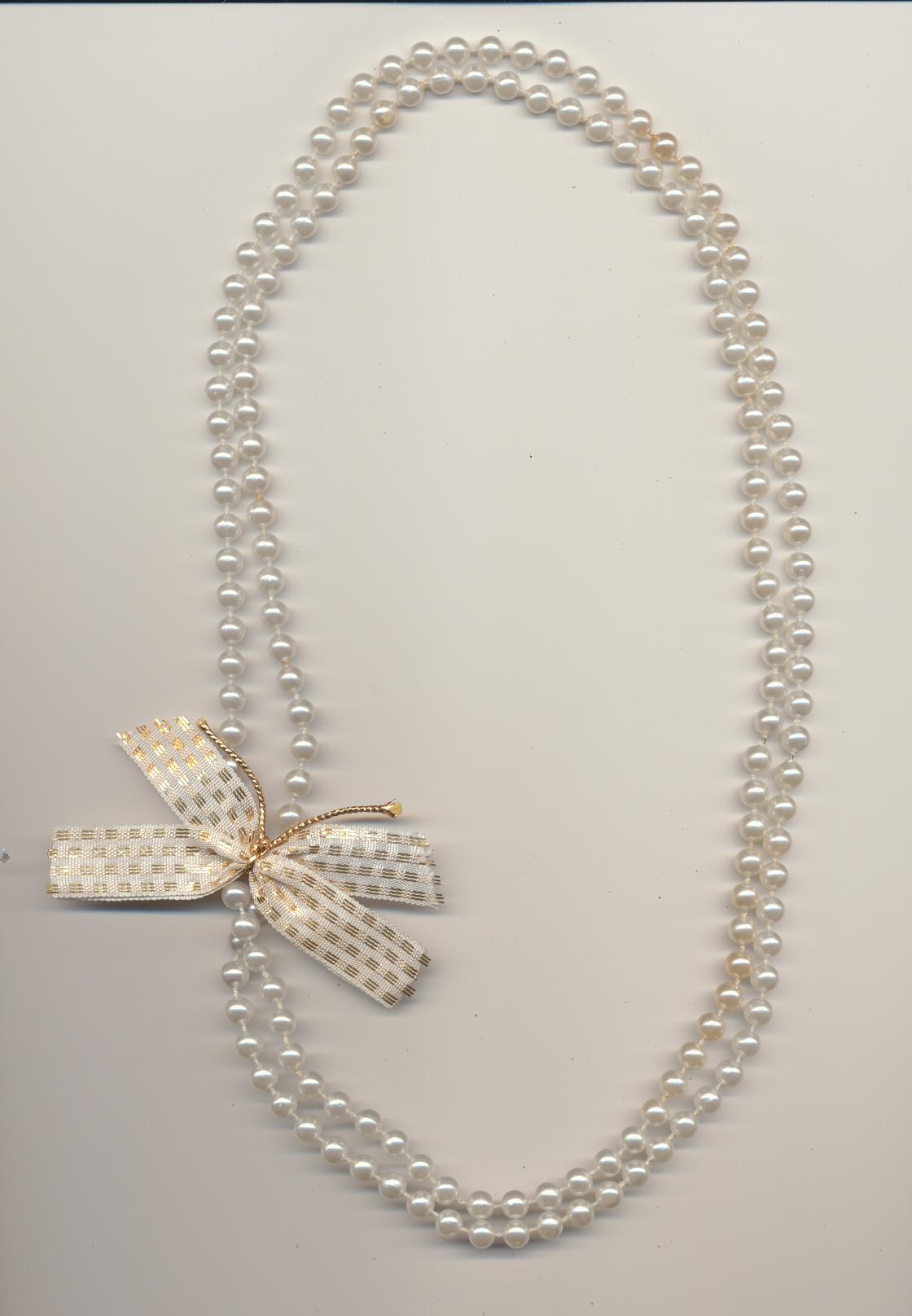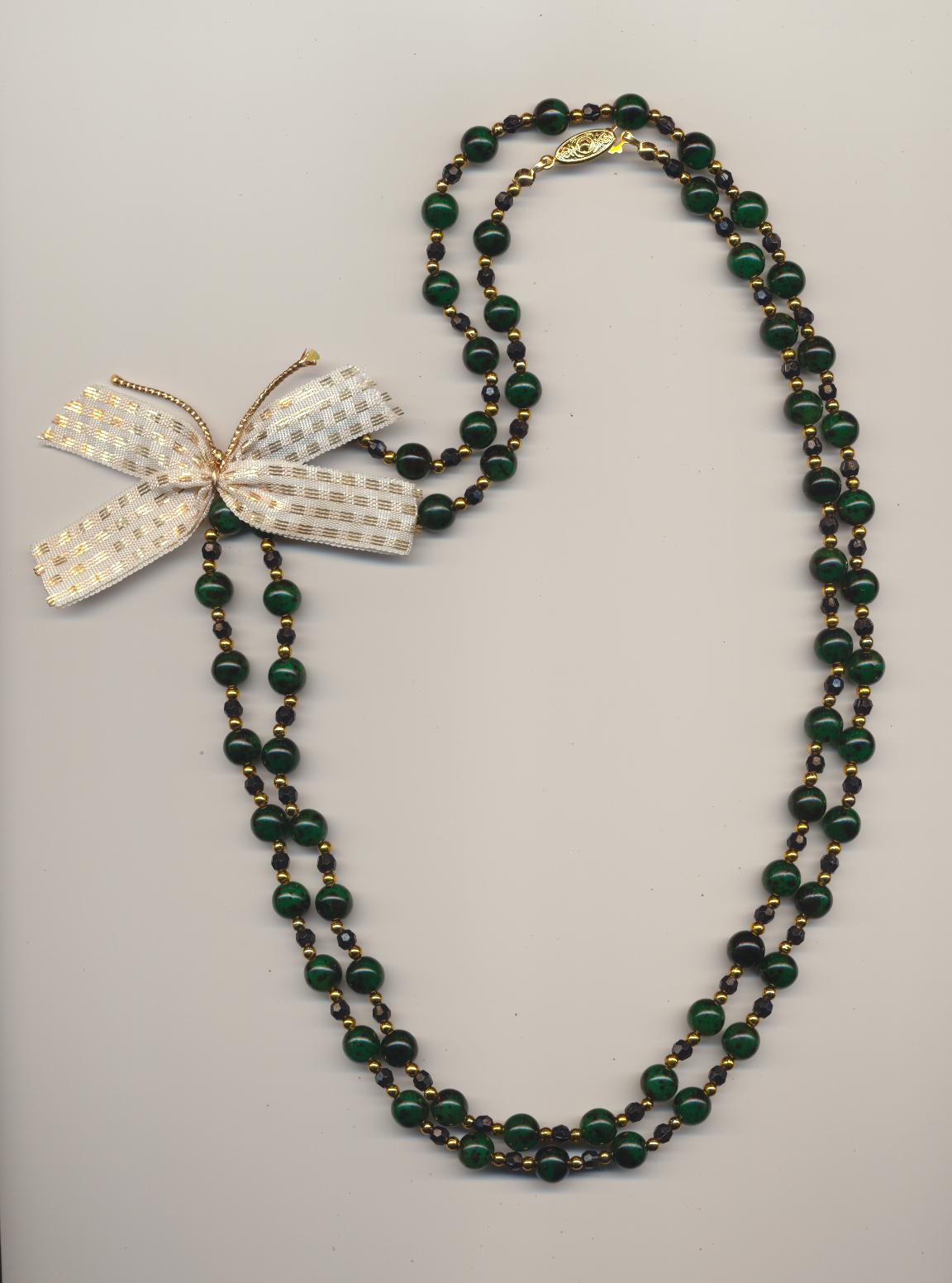Creative Necklaces Ideas For Making Your Own Bead Necklaces
Most of your own bead necklaces give you an opportunity to be creative and make of them much more. You will have satisfaction from your own creations and can be proud of them. Here are some examples:
(see also the photographs!)
If an imitation necklace of plastic blobs on a thread is broken, do not throw it away. It still can be used:

Lariat style necklace
Cut both ends of thread as close as possible to their respective "beads" with a pair of very sharp nail scissors. Put the necklace once or twice around your neck with both ends in front of you on your chest. Pull both ends, take them in your hand and make an overhand knot. Now you have made a necklace in the style of the Twenties of last century!

Fringed lariat style necklace
If you do the same with more (on purpose cut) plastic imitation necklaces together, you will get a kind of fringe effect, very nice.
Next tips hold equally for the earlier mentioned imitation necklaces of small plastic balls on a thread as well as for the longer bead necklaces made of real beads but without a closure:

Abundant necklace
Wear several necklaces of the same or of different colors together. The necklaces can be of the same length, as during in the Sixties, or of different of lengths.
Most important: you like the combination.

A choker with a long necklace together
Take a long necklace, put it on and put it another time around your neck.
Now pull one of both loops and you will end up with a short one around your throat and a long loop on your chest.

A formal two row necklace
Take a long necklace, put it on and put it another time around your neck. Pull both loops until they are of the same length.

Opulent necklace
If you perform the last two variations with two or more necklaces together but of different colors, the effect becomes even more interesting.

A three row formal necklace
Depending the length of the necklace and the circumference of your head and neck, you can put a long necklace even three times around your throat. Now you made a full, short, three row necklace, very luxurious and of some nonchalance. It shows less formal than an official necklace of three rows.

A necklace as a necktie
Put an overhand knot in a necklace in front of you, but high on the chest. Pull the knot and arrange the beads with care. This has somehow the effect of a necktie.
Do not perform this variation with a necklace made of so-called baroque stone beads (stone chips). These are cheap necklaces made of very irregular formed small stone beads. They are made of the waste material after beautiful beads are cut of it. Often these baroque stone beads have sharp edges in and around their hole and can cut through the beading thread easily. Making a knot in these necklaces causes extra traction on the thread and slides the beads on it, causing the necklace to break.
Only stone beads of the highest quality, as sold by jewelers, are cut-proof and in most cases these necklaces have knots in between the beads.

A double row bead necktie
Depending on the size of the beads you can put an overhand knot in two or more necklaces together. You can take bead necklaces of the same, matching or of contrasting colors, as you like!

A choker with a loosened necktie
Take a long necklace and put it twice around your neck.
Now pull one of both loops and you will end up with a short one around your throat and a long loop on your chest and make an overhand knot in the longer one.
Variations by means of a pearl shortener or a ribbon bow:
A pearl shortener is a loop-shaped fastener and sometimes called a necklace shortener or twister clasp. It is a round or oval metal ring with at one side a hinge and at the other a closure. It reminds a miniature bracelet. Pearl shorteners are available in a multitude of sizes and materials, big and small, silver and silver color, gold and gold color, with or without embellishments.
Especially during the Fifties the pearl shorteners were frequently used in order to make of a long (pearl) necklace a short one of multiple rows, as was en vogue during that period. Quite possibly you can find one in the jewelry box of your mother or grandmother, without knowing what it was intended for. Otherwise you can buy one via the internet or at a good (costume) jewelry shop.
If it is difficult to obtain a pearl shortener, or the beads are too bulky, than you can have the same effect by putting a ribbon bow around your necklace. You can use a ribbon in the same or a contrasting color.

A double or four strand bead necklace made of one necklace and a pearl shortener
Take one long necklace double or fourfold in front of your chest and bring the ends together in your neck. Put the pearl shortener around these ends and close it. Depending the length of the necklace, the size of the beads and the diameter of the pearl shortener you can make a double or four strand bead necklace.

A four strand bead necklace made of two necklaces and a pearl shortener
Take two long necklaces double in front of your chest and bring the ends together in your neck. Put the pearl shortener around these ends and close it. The necklaces can be identical or made of different beads and different lengths.

A twisted double strand bead necklace made of one necklace and a pearl shortener
and
A twisted four strand bead necklace made of two necklaces and a pearl shortener
As a variation of the numbers 11 and 12 you can twist the strands before closing the pearl shortener. This causes the bead necklace to make a full and rich impression.

Pay attention that before starting to twist, the two or four strands have to be of the same length. Furthermore, the necklace will be shortened by the twisting procedure.
Try on your bosom how many twists you like before the necklace start to turn around itself. Twisting can be done quickly by taking the necklace in both hands and turning both ends in opposite directions.
It is better not to twist the necklace when made of cheap stone beads as they often have sharp rims at the ends or within their holes. (see the text of variation number 8)
A dramatic necklace made of two necklaces with or without a pearl shortener
Pull one necklace through another and close them, twisted or not, in your neck by means of the pearl shortener. You can use two necklaces of the same color, but by using contrasting colors your necklace will have a dramatic effect.
With this variation you do not have to use the pearl shortener or ribbon bow, but just by pulling the necklace over your head you will make a long one out of the two.
In contrast to what you would expect, it is advisable not to use the pearl shortener for real (expensive) pearls, as it can damage them.
Variations with necklaces which do have a closure:


A boring necklace rescued by its clasp
A boring necklace can become very interesting by turning a beautiful and/or impressive clasp to the front.
The place of a clasp is determined by its form and weight. A very heavy clasp will have the tendency to be located on the lowest point of the necklace, thus on the chest, in the middle. But big flat clasps, big flat beads or metal disks, cannot be worn in front of the middle of your bosom. They tend to flip up and stand on their side. They can be worn halfway down the necklace on condition that the weight of the necklace is the same on both sides, or that a heavier element of the necklace is placed in the middle.


The twisted necklace
Multiple strands of beads of the same bead necklace can be twisted around each other. Often it is done with small garnets and small pearls. It has a full and rich effect and is especially worthwhile when each strand alone looks cheap and shabby. Bead strands of uniform length can be twisted together as well as multiple strands which are of different lengths. However, it only can be done if the closure will not turn around itself, like the screw fasteners, as unwinding of the strands will be the result.
Keep in mind that winding the strands will shorten the necklace.


from short to long and even longer
Take two or three necklaces which are made of the same or different beads but of the same clasps, or take a necklace and its matching bracelet. Closing these claps enables you to vary the length of the necklace. Examples: two necklaces of 40 cm. (16") each make a necklace of 80 cm. (32") A necklace of 40 cm. (16") and its bracelet of 20 cm. (8"), as is the usual length of a bracelet, make a necklace of 60 cm. (24"). Of course the use of beautiful clasps adds to the effect of these necklaces.
Several ideas for adding some spirit to boring bead necklaces: (They do exist!)

A ribbon, shawl, corsage or brooch as eye catcher
Knot a beautiful ribbon or thin little shawl around the necklace, or attach to it a corsage of real or imitation flowers, or a beautiful broche.

A corsage or brooch with flair
By means of this corsage or brooch you can pull the necklace somewhat aside and attach it higher on your chest which gives flair to your appearance.
These last two variations are very elegant with (imitation) pearls.





